The recently launched IBM Spectrum Fusion hyperconverged appliance helps you to work with its intuitive management graphical user interface for networking resources that associated with the appliance.
This tutorial focuses on how you can run commands for the switches on your IBM Spectrum Fusion appliance from its user interface.
Before you start with this tutorial, you can keep the IBM Documentation for IBM Spectrum Fusion handy, which also provides a good starting point for reference and learning.
As part of your network configuration, you can run a command to work with the switches. The Network page in the IBM® Spectrum Fusion user interface provides information about switches in the system.
After you have successfully installed and configured the IBM Spectrum Fusion appliance in your premises or environment, you may want to run commands for your switches for diagnostic purposes as part of the network configuration.
In your IBM Spectrum Fusion appliance, if you (as a user or a network administrator) want to check the VLAN configuration, switch status, check port connectivity status (whether it's running or not), etc., then running these commands help to derive more information. However, one should be aware about some basic networking concepts to interpret the results after running these set of commands. For these changes, you will need to carry out some steps.
So, let’s walk through this tutorial to learn and understand about how you can run commands for such switches from the IBM Spectrum Fusion user interface on to your network for the IBM Spectrum Fusion appliance.
- Log in to the IBM Spectrum Fusion appliance by using the IBM Spectrum Fusion user interface. See the following figure for reference about the welcome page:
 Figure 1: IBM Spectrum Fusion welcome page
Figure 1: IBM Spectrum Fusion welcome page
- Click Let’s get started.
- On the login page, log in to your account with your user credentials by specifying the username and password.
You are welcomed by the Dashboard page on the IBM Spectrum Fusion user interface, which consists of various sections such as Compute, Storage, Network, Events, OpenShift, Software capacity, and Backups.
You can view all the relevant information for each of these sections based on the administrative, management, or configuration actions that you have carried out earlier from the IBM Spectrum Fusion user interface.
As we are interested to know about how to run switches as part of the network configuration for the IBM Spectrum Fusion appliance, let’s understand a bit about the Network section. See the following figure for reference.
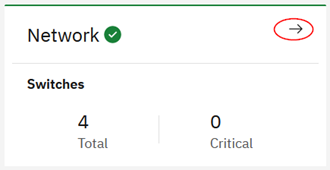 Figure 2: Network section on Dashboard
Figure 2: Network section on Dashboard
- The Network section displays information about the total number of switches, the total number of switches in critical and warning state, and the throughput and latency in GBps.
- To go to the Network page, click the arrow mark (as marked in Figure 2) in the Network section on the Dashboard Alternatively, click the IBM Spectrum Fusion Dashboard menu in the top-left corner of the user interface and click Manage > Network. See the following figure for reference.
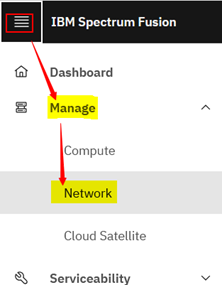 Figure 3: Menu to access Network page
Figure 3: Menu to access Network page
The Network page is displayed, which provides you with all the information about the Network configuration on your IBM Spectrum Fusion appliance. See the following figure for reference.
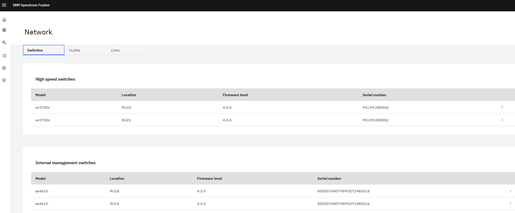 Figure 4: Network page (Switches tab by default)
Figure 4: Network page (Switches tab by default)
Three tabs (Switches, VLANs, Links) that constitute the Network page help you to configure your network configuration further that are based on your business requirements. By default, you land on the Switches page.
As we want to run commands for switches, let’s proceed with these steps:
- Click the Switches tab if you are on any other tab. The Switches section is displayed. The Switches page consists of two sections:
- High speed switches
- Internal management switches
See the following figure for reference.
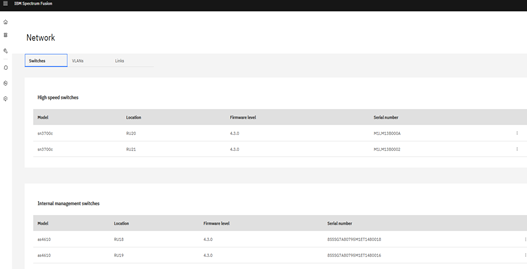 Figure 5: Network page (Switches tab)
Figure 5: Network page (Switches tab)
This page provides all the information in a tabular form for each type of switch.
The columns of the VLANs table are as follows:
- Model: Indicates the model type of the switch.
- Location: Indicates the location of the switch.
- Firmware level: Indicates the firmware level of the switch.
- Serial number: Indicates serial number of the switch.
- Optional: To view the event or power status of a switch, click the switch record. The Network page displays the following sections about the switch. See the following figure for reference:
 Figure 6: Switches events and power status
Figure 6: Switches events and power status
To return to the Switches page or tab, click Back To switches as marked in the former figure.
- Go to the switch record that you want to work with. See the following figure for reference.
 Figure 7: Switch record
Figure 7: Switch record
- At the end of the record, click the ellipses icon to view more actions and then click Run command. See the following figure for reference.
 Figure 8: Run command for selected switch record
Figure 8: Run command for selected switch record
The Run command pane is displayed.
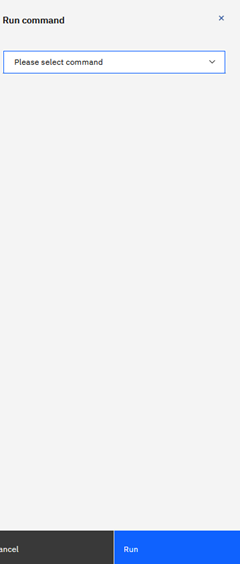 Figure 9: Run command pane
Figure 9: Run command pane
- Click the Please select command list to view the available command options for you to run and apply. See the following figure for reference.
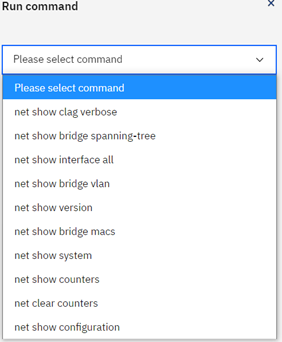 Figure 10: Run command list
Figure 10: Run command list
- Select a command option from the list.
- Click Run to apply the command to the switch. See the following figure for reference.
 Figure 11: Selected command and Run button
Figure 11: Selected command and Run button
After you click Run, a window comprises of the information about the command that you executed is displayed. See the following figure for reference.
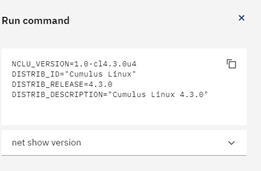 Figure 12: Command information after Run
Figure 12: Command information after Run
- Optional: If the command information is extensive, then click Show more or Show less to expand or collapse the selected option to view more information about the command. You can also use the Copy to clipboard option to copy the command information for further reference. See the following figure for reference.
 Figure 13: Show more, Show less, and Copy to clipboard actions
Figure 13: Show more, Show less, and Copy to clipboard actions
- Click Done to apply and complete the changes. See the following figure for reference.
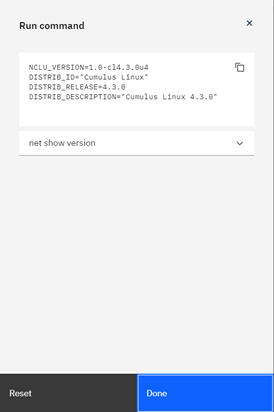 Figure 14: Done button to complete the run command
Figure 14: Done button to complete the run command
- Click Reset if you want to undo the current changes. See the earlier figure for reference.
With this procedure, you have successfully added a VLAN in the Network page of the IBM Spectrum Fusion user interface to meet your business requirement. Similarly, you can add more VLANs to your network.